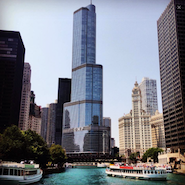- About
- Subscribe Now
- New York,
April 29, 2015

In the seven counties in the Metro Chicago region, the quarterly analysis of properties sold for more than $1 million witnessed a growth in the number of homes, but a decrease in price, according to the RE/MAX Luxury Report on Metro Chicago Real Estate.
Transaction increases and quicker turnovers present the luxury market in Chicago as potential investment hub. The increase, more specifically, in the city's real estate as opposed to the suburban towns, adds to the narrowing focus on affluent consumers in the city.
“Generally the city has been outperforming the suburbs relative to transaction numbers and price increases in top areas,” said Jim Merrion, regional director of the RE/MAX Northern Illinois real estate network.
“The risk is that escalating prices in the city and a surplus of new high-end product coming on line could cause price and feature wars among developers and potentially a temporary glut of high-end product, which would inevitably lead to flat or falling prices to move this inventory,” he said.
Trends in the windy city
Transaction activity was 16 percent higher than the quarter in 2014 for luxury homes. The total units sold were 378. Also the turnover was faster with homebuyers finding homes 14 days quicker than the year before.
Across the last two years the sales in the Metro Chicago area have grown 37 percent during the first quarter of each year.
However, the majority of this growth has been within the city as opposed to the suburban luxury sales.
In Chicago, the transaction volume was up 18 percent with 209 properties sold. The median sales price was $1,373,750, which is down from last year, but the average market time fell 10 days.
Specifically three communities within Chicago saw the most growth. These locations are Lake View, West Town and North Center.
In the suburban areas of Chicago, home sales increased 13 percent, but the median sales price dropped 3 percent.
Winnetka and Hinsdale led the suburb towns in sales this quarter.
“The suburbs are in a slightly different situation in that most of the upper-end suburbs are already developed, and the high-end new product is typically on in-fill or teardown lots, and generally is subject to a one-on-one approval process as opposed to the bulk process for say 200 units in Chicago,” Mr. Merrion said.
“In some of the less-populated upper end markets where land is more available, the builder/developer generally operates on a smaller number of units for the high-end properties, so the scale is typically smaller, and the risk less than in the example above,” he said. “In both cases, the impact on the community will be to pull prices of surrounding properties up long-term.”
The after effect
The United States’ population of ultra-high-net-worth individuals grew by 6 percent overall last year, and no states saw a decrease in this demographic, according to findings by Wealth-X.
Wealth-X’s “American Ultra Wealth Ranking 2014-2015” found that the UHNW population of the U.S. is primarily concentrated in major metropolitan areas across the country, while some states boast more than one city with a large demographic of wealth. Having access to this information can help brands and retailers determine the best areas in the U.S. to expand or fine-tune their retail footprint to better serve this discerning consumer segment (see story).
In the report, Chicago was listed as the number four market for ultra-high-net consumers.
“[The luxury markets] will have a “pull-up” effect on the neighborhoods where they are being built as in many instances these properties will now be the highest price on the block,” Mr. Merrion said.
Final Take
Nancy Buckley, editorial assistant on Luxury Daily, New York
Share your thoughts. Click here